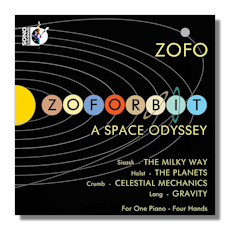
The Internet's Premier Classical Music Source
Related Links
-
Crumb Reviews
Holst Reviews - Latest Reviews
- More Reviews
-
By Composer
-
Collections
DVD & Blu-ray
Books
Concert Reviews
Articles/Interviews
Software
Audio
Search Amazon
Recommended Links
Site News
 Blu-ray Review
Blu-ray Review
Zoforbit: A Space Odyssey

Music for Piano Four Hands
- Urmas Sisask: The Milky Way: Piano Sonata, Op. 24
- Gustav Holst: The Planets Op. 32
- George Crumb: Celestial Mechanics: Cosmic Dances for Amplified Piano, Four-Hands
- David Lang: Gravity
ZOFO
Sono Luminus CD+Blu-ray Audio DSL-92178 73:03 LPCM Stereo DTS-HD Master Audio
This is a typically adventurous program from a label that's always been willing to think outside the box. That wouldn't matter were the performances not of high caliber, and they are astoundingly so. Eva-Maria Zimmermann and Keisuke Nakagoshi comprise ZOFO, a one piano, four-hand duet. Interestingly, nowhere save the booklet are their names listed, they work as one cohesive and equal unit. I like that; there's no ego or self-promotion, just great art. Sure, there's a cheesy photo in the booklet, but I suppose that's to be expected these days.
Right, the music: it's fabulous. In an industry where a “space”-themed album means movie themes and John Williams excerpts, it's great to see a program that looks for new and innovative ways to effectively explore the intergalactic premise. Surrounding a favorite like The Planets with a trio of contemporary works is nothing short of genius, and explores the artistic range of this duo in the best possible way. I don't have a Blu-ray player, but the sound is terrific in standard stereo, and the notes (silly picture aside) are well-written and easy to read. Full composer and artist biographies are included.
The program starts with a two-movement journey from European composer Urmas Sisask. Unlike most devout Roman Catholic composers, Sisask allows his work to influence, rather than dominate his work. As a practicing Catholic myself, I can only applaud this decision; it helps his work to avoid sounding pretentious and stuffy. Actually, the composer writes planetary music reasonably often, and this enthralling trip through The Milky Way draws on the piano's most percussive and primal sounds while still managing to be cohesive and engaging. It's hard to describe in words – the cosmos always is – but lovers of new music and the piano alike will appreciate this.
The Holst is easily the most well-known piece on the program. Before being scored for full orchestra, this suite (and indeed, many other pieces besides) was written down for piano, save Neptune, which was written for organ. Using the orchestral score, the two-piano arrangement, and a signed score for four-hands credited to his colleagues, ZOFO has created a suitably atmospheric version for their needs. Holst never did like the piece much, though he conducted and recorded it and it brought him great fame. It's hard to see what he could have resented; the piece is as colorful as anyone could wish. ZOFO's playing is beyond reproach. Somehow the increased transparency makes the suite seem more galactic in nature, more attuned to the various moods the composer intended. After decades of stately English orchestral performances (and some rather heavy European ones, too), we should be thankful to these performers for making the score new again. Sure, in Mars and Jupiter I do miss some of the weight orchestral forces provide, but elsewhere there is playing of great sensitivity and beauty. A triumph.
How do you follow that? With more new music to tickle the ear, obviously. The Crumb piece is fantastic; percussive, abstract, and fully typical of this modern master. Celestial Mechanics lives up to the title by managing to be both things. It's a work that suggests a massiveness within a small frame, and explores the inner workings of both sound and space. I really enjoyed it, even if like most of the program it is easier to enjoy than explain. ZOFO is remarkable, especially in the parts of the work that need to be beautifully weird. Yes, I'm aware that may be unhelpful, but I insist you try it all the same. As for David Lang's Gravity, it's another case of a composer painting such an abstract picture that it's hard to paint in words for a listener. It's a gentle piece, with dark undertones to be sure, but it says more about falling than what we could be falling into. That's rather how gravity works, and you'll either find this dull or captivating. I believed the latter, and the program as a whole is a delight. Try this for something new, because I'm very glad that I did.
Copyright © 2014, Brian Wigman





















